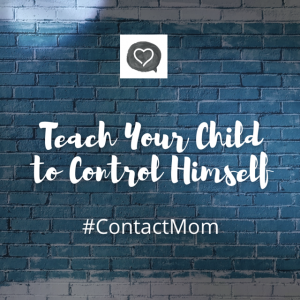He who is slow to anger is better than the mighty, And he who rules his spirit, than he who captures a city. Proverbs 16:32
We’ve probably all seen at least one funny video of a toddler throwing a tantrum for the camera…turning on and off the tears as the parent filming hides around the corner. All goes quiet until the little one comes back into view; once he sees that the parent is there, he starts up all over again. Or maybe (like me) you’ve had the opportunity to hold a 3-year-old through a tantrum because there wasn’t a place to isolate him. During the process he became more and more upset that I was holding him still. When I let him know I would let go of him when he stopped screaming, he immediately was calm and quiet.
Children as young as 9 months can be trained to play on a blanket, to keep their hands down while being fed at mealtime, and to start to use basic signs to communicate “please”, “thank you”, “more” or “all done.” We call the capacity to do these things “self-control”. The examples above demonstrate that even very young humans have this ability. The simple definition of self-control from Merriam-Webster is “restraint exercised over one’s own impulses, emotions, or desires.”
As parents, we need to strengthen and encourage self-control in our children because it is a foundational virtue for life. Obedience, focusing, completing a task, sharing, and kindness all rely on some level of self-control.
I always said I was my child’s self-control before he had any. Before the age of reason, children need concrete consequences for when they show a lack of control. As the child is trained and matures, motivations become more and more internalized. Then, my role as the parent is to encourage my kids to ‘find’ their self-control. Just like a muscle, self-control must be exercised and strengthened. Here are some helpful tips for training your child in self-control:
- Start with the positive. Encourage your children from an early age by showing them what you want them to do and praising them when they do it. “Great job staying on the blanket!” “You waited so patiently for Mommy without fussing! Well done!”
- Have them practice it right. When you are working on an area of self-control like teaching sign language and your baby fusses instead of signing “please”, you may say, “Mustn’t fuss, use your words.” At the same time, take his hand through the motion and say “please” before you give him what he is asking for.
- When your child shows a lack of self-control, give a consequence. Depending on the context, you may need to remove the temptation from the child, remove the child from the situation, or isolate him. For example, if you are blanket training and your child is frequently tempted to get off the blanket, you may need to just remove him to a pack-and-play after one or two reminders. If he is complying but screaming in protest, you may wish to isolate him. Recently I was working with my 1-year-old grandson on this very skill. He was frustrated and cried when I told him he must stay on the blanket. So I asked him if he would rather play in his pack ‘n’ play and he shook his head no. He quit fussing and began to play with his toys. He knew I was resolved to back up my instruction and this helped him to have self-control. He played contentedly for the better part of an hour without further protest.
- For the wiggles, you can teach your toddlers and pre-schoolers to fold their hands. This is a great tool for helping to calm a situation before it gets out of hand. My daughter teaches her 2nd grade students a little rhyme to sit “criss-cross applesauce” and put their hands in their laps before read-aloud time. This helps them to prepare to sit still and listen and encourages self-control right from the start.
- When emotions run high – In our house this included excessive silliness as well as meltdowns and outbursts of anger. Whenever possible, try to intervene before things get out of control. When things began to escalate, we would often require our children to have some reflective sit-time. We would have them think about the direction they were heading and what the outcome would be if it continued. Then we asked them how they should change their behavior for a more positive result. Having them sit and think sooner rather than later gives them a chance to learn and practice strategies for bringing themselves under control in the future. We used isolation and loss of privileges for those times when their emotions got the better of them. Then when emotions died down, we talked about what to do next time.
- Teach in a time of non-conflict through stories and examples. Children learn best when they are not the ones on the “hot seat.” Use stories to demonstrate the value of self-control in a given area. When you see your child tempted, you can recall these stories to your child and encourage him to practice self-control. If your child is struggling in an area of self-control, find real life examples to point out. We found it most effective to give examples from our own lives. This can be a powerful influence, especially in the pre-teen and teen years, when our kids could see that we are just humans with similar struggles. When we model self-control in trying circumstances for them, we give them the courage to do the same.
There is great value in taking the time to proactively train our children in the virtue of self-control. By starting young and teaching and encouraging them at each stage of development, we set them up to be successful in all of life because they will have learned to rule their spirits well.





Leave a Reply